

| Invasive invertebrates and some recent Nottinghamshire colonists | ||
| ..... | ||
| In early June 2012, we
were watching a foraging worker Tree-nesting Bumblebee on
Valerian in our small terraced garden. Nothing much
unusual in such a sighting now, but just a few years ago,
seeing our first at Gamston Wood near Retford caused a
great deal more excitement. Excitement was hastily followed by some panic in trying to obtain a photograph before it flew off, but then satisfaction at finally having recorded a species we had been looking out for over the last two or three years since it's arrival, colonisation and further range expansion up from the south-east UK. First arriving in the UK in 2001, our Gamston Wood record came in 2010, a year after the Tree-nesting Bumblebee (Bombus hypnorum) had first appeared in Nottinghamshire and by the first warm weeks of Spring 2012, Bombus hypnorum queens had become one of the commonest Bumblebees we saw and this trend looks set to continue over the next decade. |
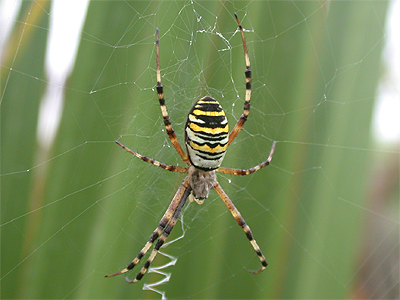 |
|
| ..... | ||
| Two
infamous arrivals of recent years Several invertebrates that recently made it here are invasive by their very nature, whilst others have naturally started to spread away from the confines of south coastal areas, following the trend for increasingly milder Winters and warmer climate generally by moving north. Whilst many naturally colonising species such as Bombus hypnorum, ultimately offer little or no threat to the existance of any of our native insects, the same has not always been said regarding two of Nottinghamshire's most recent colonisers - the invasive Harlequin Ladybird and the Horse Chestnut Leafminer. The Harlequin Ladybird (Harmonia axyridis) first appeared in the UK in 2004. Within the space of a couple of years, it had reached the north-west of England and the Welsh borders. After it's arrival, the Harlequin has continued to colonise new areas of the country and substantially strengthened existing populations in the south-east. In parts of London it soon became the commonest ladybird you could see. When a Harlequin Ladybird was found in Derby in October 2004, it was easy to suggest that it would be found in neighbouring Nottinghamshire in 2005. But it seems as though its move into Nottinghamshire never happened, if the lack of submitted records or potential sightings is anything to go by. In the end, Nottinghamshire only had to wait until the end of July 2006 before we found the county's first acceptable record at Eakring Meadows NR. |
||
| ..... |
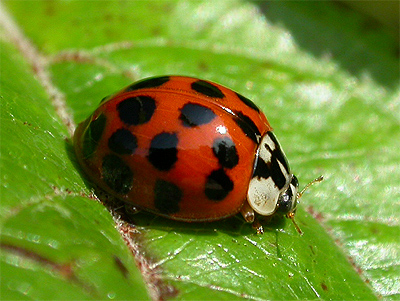 |
Regular visitors to this
website will know that we have always played down the
Harlequin threat, firmly believing it to be hyped-up
beyond belief and the more we watch this beetle, the more
we continue to be convinced that there is little threat
to our native species. We do seem to be alone in this,
certainly not finding any other website with positive
views regarding the Harlequin and we do spend a great
deal of time talking to people about it. But certainly,
the adverse publicity generated by the Harlequin's UK
arrival, succeeded in convincing the public that it was
public enemy No 1. Predicting the next new invertebrate for the county list is relatively easy when dealing with invasive species colonising, then spreading rapidly northwards from the point of colonisation. The Horse Chestnut Leafminer (Cameraria ohridella) was a prime example. We began actively looking for this moth in 2007 and found it within a couple of weeks at Nettleworth Manor, Mansfield Woodhouse in July 2007. |
|
| ..... | ||
| Within just a
few days of the original discovery, low-level
infestations were found at Attenborough, Mapperley,
Daybrook and Arnold areas of Nottingham, then in the
north of the county at Carburton and central Worksop. The
moth was obviously extremely widespread throughout
Nottinghamshire in 2007, but generally at a fairly low
infestation rate based on evidence produced at the time.
However, higher infestation rates were then discovered at
Oxton, suggesting that C. ohridella had definitely
arrived there in 2006 and probably some time in 2005. At
the end of July 2007, trees with a considerably higher
rate of infestation than those at Oxton were found in
Caunton and the infestation rate would have meant that
this moth had certainly reached Nottinghamshire as early
as 2005, when it reached the neighbouring counties of
Derbyshire and Leicestershire. The Horse Chestnut Leaf Miner was only discovered near Macedonia in 1985. It was originally known from Greece in the 1970's, but not recognised as a separate species until 1985. It then spread rapidly to other European countries, before reaching the UK (at Wimbledon) in 2002, but was considered likely to have arrived the previous year due to the number of mines found. By 2012, there can hardly be a Horse Chestnut in the county that is not affected by this small moth. Red flowering Horse Chestnuts are less prone to infestation, but there is no current evidence to suggest that trees suffer long term damage through continuous heavy infestations. |
| ..... | ||
| A North American
import The Western Conifer Seed Bug is a large North American species and a Nearctic pest of conifer seed nurseries. It was first recorded in Europe from Italy in 1999, possibly via imported timber. It spread rapidly, appearing in the UK for the first time in 2007 at Weymouth, with further records coming during the latter part of 2008. Most of these records came from MV moth traps operated along the south and south-east coasts and this bug is now regular in such circumstances during most Autumns. Adults have even reached inland as far north as Kendal in Cumbria. Much nearer to Nottinghamshire, there have been records from Quorn (Leics) and Charlesworth (Derbys). Nottinghamshire's first record was on some bedroom curtains at a house in Eakring on September 27th 2009. Thankfully, the finder emailed a picture to us for identification and retained the specimen, which we hastily collected and photographed. A more recent second record has been related to us from Gedling from 2011, when one was found crawling up an outside wall. |
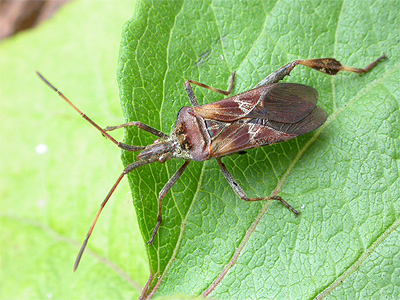 |
|
| ..... | ||
| All records
of the Western Conifer Seed Bug are supposed to be sent
to DEFRA. There are no records of this bug breeding in
the wild state as yet (2012), but this is now considered
to be very likely due to it's rapid colonistation and
spread across Europe within ten years. ... and a UK first on a Worksop house wall Although invertebrates invariably turn up in the strangest of places, the wall of a Worksop house would not be the first place even we would look to find a species new to the UK. Recording and photographing invertebrates, many times throws up something obviously very different from what you have seen before, but still remains unidentified despite a great deal of research. The result is that the images get put into the 'unidentified folder' and often sit there for months or even years. Images of a Leiobunum type Harvestman and with a leg span that was greater than the depth of a house brick taken at Worksop in October 2009, did exactly that. Yet the inability to ID it, probably niggled us more than any other species and the 'unidentified folder' was subsequently opened several times in the intervening period. |
||
| ..... | ||
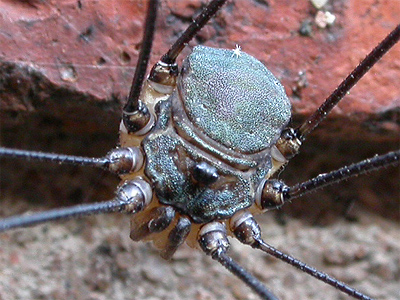 |
In November 2011, a
possible breakthrough came whilst searching for images of
Platybunus pinetorum, a recent addition to the
UK species list discovered by Paul Richards at Sheffield
in June 2010. Images found during a Google search for the
similar looking (to the Worksop specimen) Leiobunum
tisciae, turned up images of an invasive and unknown
Leiobunum sp found in parts Germany,
Switzerland, The Netherlands and Austria. Further
research quickly led us to the excellent paper "An
unidentified harvestman Leiobunum sp. alarmingly invading
Europe" (Arachnida: Opiliones) by Hay
Wijnhoven, Axel L. Schönhofer & Jochen Martens
and published in December 2007. One particular image of a male in the paper, seemed to match the Worksop specimen perfectly, so we emailed images of the Worksop specimen to Jochen Martens and Paul Richards for possible identification and confirmation. Both replied back with the conclusion that this was indeed Leiobunum sp, notable for its extremely long legs and for forming enormous congregations of up to 1,000 strong on the walls of buildings. |
|
| .... | ||
| It is
believed that this Harvestman arrived in Europe via
importation. The first records came from near Nijmegen,
The Netherlands in October 2004. Experts using Martens
1978 key, could not identify it as being any
north-western or central European species, nor were they
able to assign it to any European representative of the
genus known to date. Many more additional records were
obtained from several localities near to Nijmegen during
2005 and 2006. First records from other European
countries are Germany and Austria (2006) Switzerland
(2007) and from France in 2009. The arrival of this Harvestman in the UK could possibly have effects on some of our native species, but our 2009 record remains the only UK record to date, although surveys of the Worksop estate where it was found are planned for the Autumn of 2012. It is extremely unlikely that this was a one off record. The accidental importation and introduction of invertebrates into the UK via transport includes one spider that can be looked for at any garden centre. The Feather-legged Lace Weaver (Uloborus plumipes) arrived via the house plant trade and has become common throughout much of the UK in glasshouses at Garden Centres, after it first appeared here as long ago as 1990. It cannot survive our Winter outside and originates from Europe, Africa and Asia. It first appeared at Garden Centres in Reading, Liverpool and Southampton and has since spread and seems to be common where it occurs. We found it almost immediately, when we checked a Garden Centre at Mapperley, Nottingham in April 2010. Webs containing adults were found in the roof support frames of each glasshouse we checked. Uloborus plumipes has a distinctive resting posture, making it difficult to find when on the stems of woody plants and the spider shows a range of colour variations. While on about some of our latest new spiders, mention should be made of one particularly stunning species, that could well be about to make the move into Nottinghamshire properly. The Wasp Spider illustrated at the top of this page, is probably the one species at the top of our personal 'most wanted' list. There is a record from the very south of Nottinghamshire and it is possible that searches of rough fields and uncut grass verges north of Upper Broughton could pay dividends. The Wasp spider has been in the UK for many years, yet could only be found along the south coast. With the general warming of the UK's climate, a northwards range expansion has occurred and there are records for Lincolnshire (possibly east of Wellingore and Navenby) and Derbyshire (near Mercaston). Anywhere in south Nottinghamshire could produce further records, if it has actually colonised the county, maybe a site like Attenborough could be the place to look? |
||
| .... | ||
| Another introduced
invertebrate is the Rosemary Beetle (Chrysolina americana).
This beautiful beetle, showing a rainbow like colouration
when viewed closely, is another invertebrate that has
appeared relatively recently in the UK. Despite its Latin name, this beetle does not originate from America, but was originally a southern European species. It first appeared in the UK in the 1990's and has steadily spread north since. Nottinghamshire's first records seem to have occurred in 2009 from sites in Nottingham and Newark. This was a beetle we had looked for during the last few years and our first record came when six adults were found in the courtyard of the old Edwinstowe Craft Centre, now home to the Sherwood Forest Trust on 01/06/11. The adults are around 8-9mm and can potentially be found on Rosemary, Lavender and other herbs, yet despite being looked for, we have had no further records, but the Edwinstowe population is still doing well. |
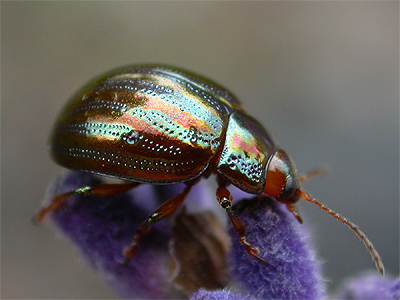 |
|
| .... | ||
| Another
member of the Chrysomelidae family (leaf and flea
beetles) the striking red and black Lily Beetle (Lilioceris
lilii) needs no introduction. Despite its pillar box
red colour, this beetle fast became a pest species for
gardeners after it spread rapidly throughout the UK. Both
the adults and larvae can cause considerable damage to
Lilies and Fritillaries by defoliating them, but in heavy
infestations the flowers, seed capsules and stems will
also be eaten. The Lily Beetle is not native to the UK,
but has been accidentally imported into the country on
several occasions in the past and has reached as far
north as Scotland. Originally confined to Surrey since
the 1940's, the Lily Beetle suddenly expanded its range
considerably in the 1980's. More recently, we have
started to find this beetle away from urban gardens, with
records coming from the middle of woodland at Bradmer
Hill near Market Warsop and the Sherwood Forest Visitor
Centre in May 2012. The Median Wasp (Dolichovespula media) is a fairly recent UK colonist, first appearing in 1980 and quickly spreading northwards. It is a large species and at first glance distinguishable from most other wasps by the greater amount of black on the abdomen, but this is not always a reliable identification character. Nests are typically found in hedgerows. The queens are large and look very much like a worker Hornet. Sometimes known as the French Wasp, Dolichovespula media is widespread and common across most of Nottinghamshire. Orthoptera (Grasshoppers and Crickets) has contributed no less than three species to Nottinghamshire's fauna in recent years, with Long-winged Conehead, Short-winged Conehead and Roesel's Bush Cricket all colonising the county since 2000. |
||
| .... | ||
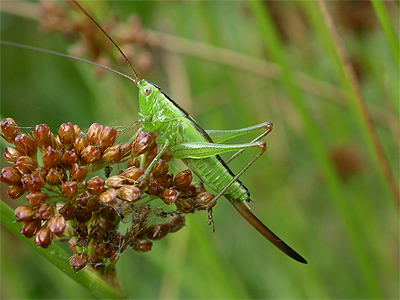 |
The Long-winged Cone-head
(Conocephalus discolor) is a large species.
Nottinghamshire's first record of
this rapidly spreading species,
came in August 2007 when it was first discovered at
Keyworth Meadow in the far south of the county. It was
then found at Attenborough Nature Reserve and spread
north-east up the Trent Valley over the next few years.
In August 2011, it was discovered at Shirebrook Pit Wood
by Roy Frost, where these photographs were taken. Roesel's Bush Cricket (Metrioptera roeselii) arrived in Nottinghamshire by the A453 near Clifton during 2006 and the following year was found at Collingham, Stoke Bardolph and Langford Lowfields. The high-pitched sound made by the male is difficult to hear, but we found them even more difficult to actually see them, rahter than hear them. Persistence finally paid off when we managed to photograph one of several stridulating males at Langford Lowfields on 26/08/07. They have continued to increase since then and have crossed to the west of Nottinghamshire, being found at Shirebrook Pit Wood in 2011. |
|
| .... | ||
| Short-winged Conehead (Conocephalus dorsalis) is a much more recent colonist, being found by Richard Rogers at Attenborough NR in August 2011. Further evidence of their move into Nottinghamshire soon emerged when Roy Frost found them at Gunthorpe. | ||
| .... | ||
| New
species potential So the potential for new species to be found is endless, but what invertebrates should be looked out for? Actually finding invertebrates completely new to the Nottinghamshire fauna is often not that difficult, as many groups are still recorded by just a handful of observers. Even in this modern day and age, micromoths, beetles, spiders and flies etc are all rarely given a second look and many 6mm long moths completely new to Nottinghamshire, have doubtless been tossed aside and completely ignored at an MV light. We recently recorded the county's first Cherry-bark Moth (Enarmonia formosana) after recognising its larval feeding signs in some logs we were given as firewood. The logs had originated from a garden in Nottingham, so this stunningly marked little moth has obviously been here for a while and we didn't even know. Two of the most likely invertebrates to reach Nottinghamshire next could both be bugs. The beautiful red and black Rhopalid bug Corizus hyoscyami should be looked for on wasteground and which has occurred in Leicestershire several times now, or the Brassica Bug Eurydema oleracea. If its a spider you want to look out for, then the False Widow (Steatoda nobilis) could well move north with people and turn up around someone's garage or house. Then again, you can never totally rule anything out. |